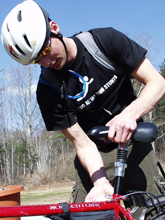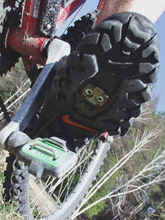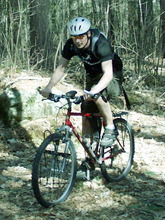Vermont Biking Safety
Bike Maintenance Safety Equipment – Advanced Riding
 Welcome to the Vermont Mountain Biking Guide, an informative guide to Vermont mountain biking sites, bike tours, bike trials, and bicycling routes. Make a selection below to view suggestions for a Vermont biking adventure. Find Vermont bike trails and cycling locations in every region of Vermont – there are hundreds of miles of mountain biking trails and bicycle routes. Come to Vermont to ride, explore, and improve your mountain biking skills, take a guided bike tour, or find a dirt road and make your own bicycling route! Ask us about VT biking or share comments. To feature your VT business, contact us.
Welcome to the Vermont Mountain Biking Guide, an informative guide to Vermont mountain biking sites, bike tours, bike trials, and bicycling routes. Make a selection below to view suggestions for a Vermont biking adventure. Find Vermont bike trails and cycling locations in every region of Vermont – there are hundreds of miles of mountain biking trails and bicycle routes. Come to Vermont to ride, explore, and improve your mountain biking skills, take a guided bike tour, or find a dirt road and make your own bicycling route! Ask us about VT biking or share comments. To feature your VT business, contact us.
Vermont Bike Safety & Bicycling Routes
 There are some basic things you should remember before getting back on your road bicycle or mountain bike. The winter season is dry and dusty, which is hard on a bike because of all the moving parts. It is best to take your bike in for a tune up at least once a year and have everything re-greased and adjusted. If a tune up is not in order, you should at least lubricate your chain. Be sure your tires have plenty of tread. Also check the tire pressure and inflate to the recommended pressure on the sidewalls of your tires. Make adjustments to the height of your seat post and handlebars if you have grown, or to accommodate your riding style. Typically your leg should be almost fully extended at the furthest pedal point. If you are going to be trail riding, a slightly lower seating may be more desirable.
There are some basic things you should remember before getting back on your road bicycle or mountain bike. The winter season is dry and dusty, which is hard on a bike because of all the moving parts. It is best to take your bike in for a tune up at least once a year and have everything re-greased and adjusted. If a tune up is not in order, you should at least lubricate your chain. Be sure your tires have plenty of tread. Also check the tire pressure and inflate to the recommended pressure on the sidewalls of your tires. Make adjustments to the height of your seat post and handlebars if you have grown, or to accommodate your riding style. Typically your leg should be almost fully extended at the furthest pedal point. If you are going to be trail riding, a slightly lower seating may be more desirable.
 Once your bike is tuned and adjusted, there are still many things to keep in mind. Always obey the rules of the road. Bikes are treated much the same as a car. Bike on the same side as you would drive, always signal when turning, and be aware and courteous of others on the road. When biking you may encounter some challenging objects in your path. Roots, curbs, and especially train tracks can cause very painful falls if crossed improperly. Any obstacle should be crossed at a 90 degree angle. If you cross railroad tracks at a smaller angle, your tire could twist and become stuck in the track and you could be thrown from your bike.
Once your bike is tuned and adjusted, there are still many things to keep in mind. Always obey the rules of the road. Bikes are treated much the same as a car. Bike on the same side as you would drive, always signal when turning, and be aware and courteous of others on the road. When biking you may encounter some challenging objects in your path. Roots, curbs, and especially train tracks can cause very painful falls if crossed improperly. Any obstacle should be crossed at a 90 degree angle. If you cross railroad tracks at a smaller angle, your tire could twist and become stuck in the track and you could be thrown from your bike.
Having the right equipment can make for a much more enjoyable biking experience.
- The most important item to remember when biking is a helmet. A hard fall is never planned, so don’t ever ride without a helmet. Make sure your helmet fits you properly. If you shake your head forward and backward, your helmet should not slide around. Install the proper lining pads to ensure a snug fit. Adjust the straps around your ears so they form a “V” joining closely under your earlobes, and remove all the slack from the chin strap. I loose fitting helmet is almost as bad as not wearing a helmet.
- Bike gloves are also a good idea. Not only will they absorb some shock
 and keep your hands from getting scraped in the event of a fall, but they will also prevent painful blisters from friction with the handlebars.
and keep your hands from getting scraped in the event of a fall, but they will also prevent painful blisters from friction with the handlebars. - Sunglasses or even glasses with clear or yellow lenses are great to have. Yellow tinted glasses can improve your vision during bad weather. Glasses also help by cutting down on strong winds, and deflecting any debris or bugs.
- Carrying extra water is a must. It is better to have too much water than to be dehydrated. Water can also be useful for washing out a cut, or clearing mud from your bike.
- Carry a few emergency tools at all times. Nothing cuts into a long day of biking quicker than not being able to fix a broken chain or flat tire. Having a chain repair tool, extra tire tube, air pump, and a few other emergency tools can really save the day.
 For riders wanting to advance their bike riding skills, here are a few helpful tips. When biking, try to stay seated most of the time. Biking while raised from the seat will expend extra energy, and you will tire faster.
For riders wanting to advance their bike riding skills, here are a few helpful tips. When biking, try to stay seated most of the time. Biking while raised from the seat will expend extra energy, and you will tire faster.
Get into a quicker rhythm when you pedal (around 1 revolution per second). Pedaling faster doesn’t mean straining harder or using more effort. Adjust your gears to stay at a consistent rhythm, which will help you conserve energy and keep your heart at a steadier rate.
An easy way to gain power and control over your bike is to invest in either toe clips or clipless pedals. Toe clips are relatively cheap, and allow you to pull upward as well as push down on your pedals to increase pedaling power.  Clipless pedals require special shoes as well, but if you are really looking to improve your biking, this is the route to go. This configuration allows for a large gain in pedaling power, and lots of control over your bike. When first learning to use clipless pedals, practice while stationary leaning against something, and then on soft ground at slow speeds where it won’t hurt to fall over. Unclipping from clipless pedals requires an awkward twisting motion and can be difficult to master.
Clipless pedals require special shoes as well, but if you are really looking to improve your biking, this is the route to go. This configuration allows for a large gain in pedaling power, and lots of control over your bike. When first learning to use clipless pedals, practice while stationary leaning against something, and then on soft ground at slow speeds where it won’t hurt to fall over. Unclipping from clipless pedals requires an awkward twisting motion and can be difficult to master.
Another good investment to help advance as a rider is a water hydration pack (backpack style water retaining pack with external tube). These packs allow you to carrying lots of extra water, and to quickly and easily hydrate on the move.
~ Erik T for vtliving.com
Vermont Bike Trails by Region
VT Lodging Guide | VT Maps | VT Attractions | VT Realty
Vermont Products | Visit VT Towns | FWM 24/7 Shopping
Country Weddings | New England Recipes
VT Inns | Red Sox Gifts | Travel Destinations
New England Living
Fitness and Sports Products On Sale Now
Join Amazon Prime - Watch Thousands of Movies & TV Shows Anytime - Start Free Trial Now
Free World Mall
Country Weddings | Vermont Products | New England







